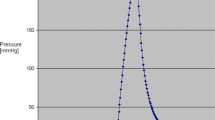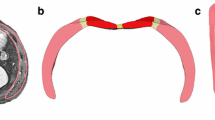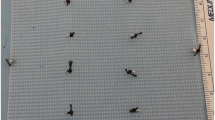Abstract
Background
The ideal mesh for hernia repair has yet to be found, in addition our knowledge of the biomechanics of the abdominal wall is poor. The aim of this study was to develop a computer model of a laparoscopic ventral hernia repair and to test different meshes in that model at various intra-abdominal pressures.
Methods
Four meshes were tested in a computer model of a ventral hernia. Mechanical failure testing of each mesh was performed in both the longitudinal and transverse directions. A CT scan of a patient with a 5 cm umbilical hernia was used to generate a 3 dimensional model. Meshes were then applied to the model in an intraperitoneal onlay position with a 5 cm overlap. The model was then tested with intraabdominal pressures for standing, coughing and jumping with and without meshes.
Results
Meshes varied significantly (p < 0.001) in both rupture force 14.8 (5.6) to 78 (5) n/cm and force in which they changed from elastic to plastic 1.6 (0.1) to 14.2 (0.2) n/cm. When applied to the computer model all significantly reduced the strain on the abdominal wall from 17.5% without mesh to less than 1% with mesh. All meshes prevented the hernia from bulging in the model.
Conclusions
We have developed a computer model of laparoscopic ventral hernia repair based on engineering principles. This model demonstrated that meshes tested significantly reduced the strain on the abdominal wall. Further studies are required to refine this model in order to best simulate the biomechanics of the abdominal wall.


Similar content being viewed by others
Data availability
Available if requested.
References
Baylón K, Rodríguez-Camarillo P, Elías-Zúñiga A, Díaz-Elizondo JA, Gilkerson R, Lozano K (2017) Past, present and future of surgical meshes: a review. Membranes (Basel) 7(3):47. https://doi.org/10.3390/membranes7030047
Zhu LM, Schuster P, Klinge U (2015) Mesh implants: an overview of crucial mesh parameters. World J Gastrointest Surg 7(10):226–236
Bilsel Y, Abci I (2012) The search for ideal hernia repair; mesh materials and types. Int J Surg (Lond, Engl) 10(6):317–321
Bringman S, Conze J, Cuccullo D, Deprest J, Junge K, Klosterhalfen B, Parra-Davila E, Ramshaw B, Schumpelick V (2010) Hernia repair: the search for ideal meshes. Hernia 14(1):81–87
Konerding MA, Bohn M, Wolloscheck T, Batke B, Holste JL, Wohlert S, Trezewik J, Forstemann T, Hartung CC (2011) Maximum forces acting on the abdominal wall: experimental validation of a theoretical modeling in a human cadaver study. Med Eng Phys 33(6):789–792
Levillain A, Orhant M, Turquier F, Hoc T (2016) Contribution of collagen and elastin fibers to the mechanical behavior of an abdominal connective tissue. J Mech Behav Biomed Mater 6:308–317
Hernandez-Gascon B, Mena A, Pena E, Pascual G, Bellon JM, Calvo B (2013) Understanding the passive mechanical behavior of the human abdominal wall. Ann Biomed Eng 41(2):433–444
Shirah B, Shirah H (2016) The effectiveness of polypropylene mesh in the open and laparoscopic repair of divarication of the recti. J Med Implants Surg 1(1):1–4
Cooney GM, Moerman KM, Takaza M, Winter DC, Simms CK (2015) Uniaxial and biaxial mechanical properties of porcine linea alba. J Mech Behav Biomed Mater 41:68–82
Cobb WS, Burns JM, Kercher KW, Matthews BD, Norton JH, Heniford BT (2005) Normal intraabdominal pressure in healthy adults. J Surg Res 129(2):231–235
Lyons M, Mohan H, Winter DC, Simms CK (2015) Biomechanical abdominal wall model applied to hernia repair. BJS 102(2):133–139
Ogneva IV, Ushakov IB (2012) The transversal stiffness of skeletal muscle fibers and cardiomyocytes in control and after simulated microgravity. In: Frewin C (ed) Atomic force microscopy investigations into biology‐from cell to protein. Intechopen, pp 1–33
Song C, Alijani A, Frank T, Hanna G, Cushieri A (2006) Elasticity of the living abdominal wall in laparoscopic surgery. J Biomech 39(3):587–591
Klinge U, Klosterhafen B (2012) Modified classification of surgical meshes for hernia repair based on analyses of 1000 explanted meshes. Hernia 16(3):255–258
Hood AJ, Coza MJ, Grant DA, Ostdiek AM, Bachman SL, Grant SA (2013) Material characterization and histological analysis of explanted polypropylene, PTFE and PET hernia meshes from an individual patient. J Mater Sci Mater Med 24(4):1113–1122
Deerenberg EB et al (2016) Mesh expansion as the cause of bulging after abdominal wall hernia repair. Int J Surg Case Rep 28:200–203
LeBlanc K (2015) Proper mesh overlap is a key determinant in hernia recurrence following laparoscopic ventral and incisional hernia repair. Hernia 20(1):85–99
Weissberg D. The engineer design revolution CAD theory, Chap 22. http://www.cadhistory.net/22%20Analysis.pdf. Accessed 1 May 2021.
Acknowledgements
We would like to thank Nicholas Dodds for his help in developing the computer model at the Department of Engineering, University of Glasgow. We would also like to thank the companies mentioned in the Methods section for their kind donation of meshes.
Funding
No Funding.
Author information
Authors and Affiliations
Corresponding author
Ethics declarations
Conflict of interest
The authors declare no conflict of interest.
Disclosure
Haitham Qandeel, Cindy Chew, Kathleen Elizabeth Tanner and Patrick Joseph O’Dwyer have no conflicts of interest or financial ties to disclose.
Ethical approval
IRB review waived: the anonymised CT scan was from a prospective cohort of patients being assessed for suitability for incisional hernia repair.
Consent for publication
All authors consent to publication.
Additional information
Publisher's Note
Springer Nature remains neutral with regard to jurisdictional claims in published maps and institutional affiliations.
Rights and permissions
About this article
Cite this article
Qandeel, H., Chew, C., Tanner, K.E. et al. Testing meshes in a computer model of a laparoscopic ventral hernia repair. Surg Endosc 36, 4124–4128 (2022). https://doi.org/10.1007/s00464-021-08735-0
Received:
Accepted:
Published:
Issue Date:
DOI: https://doi.org/10.1007/s00464-021-08735-0




